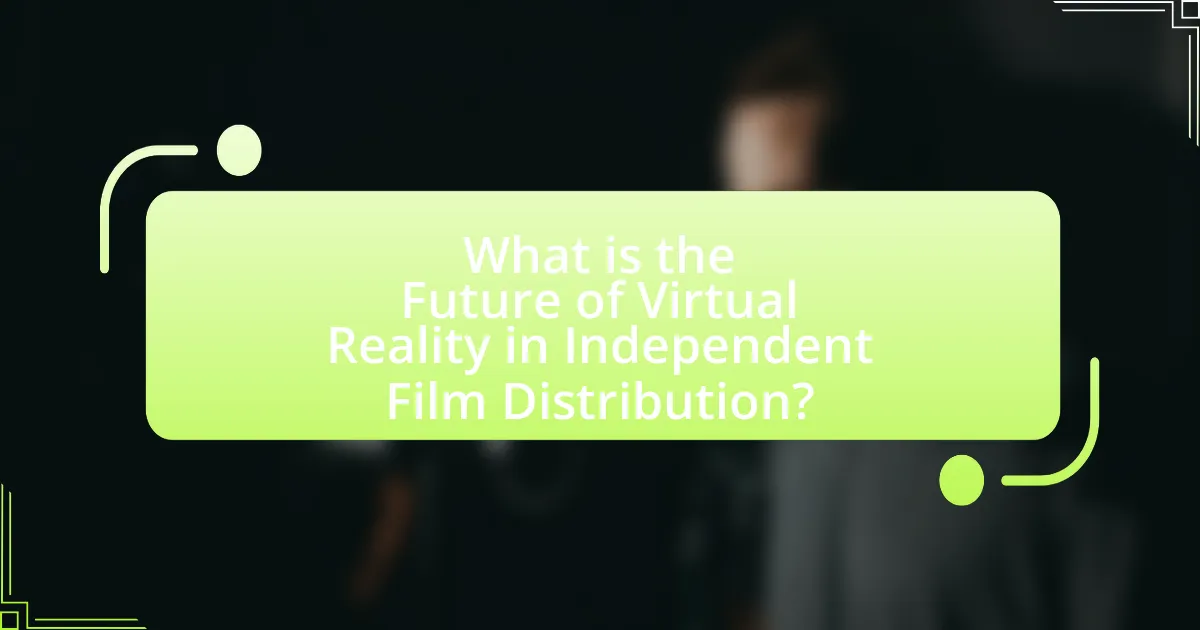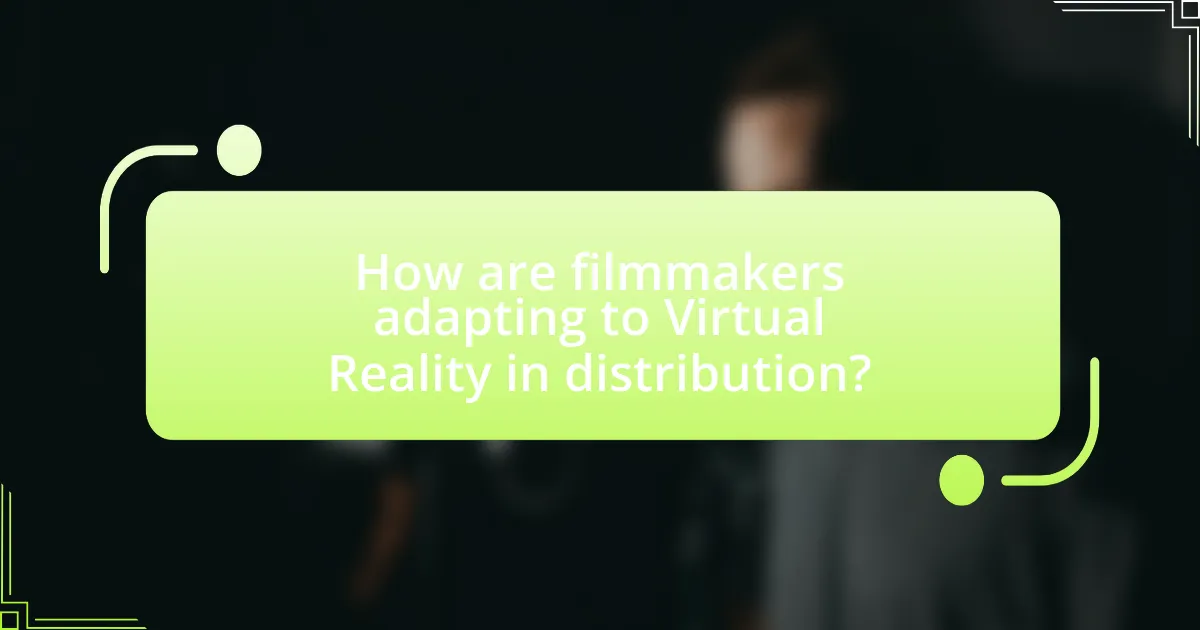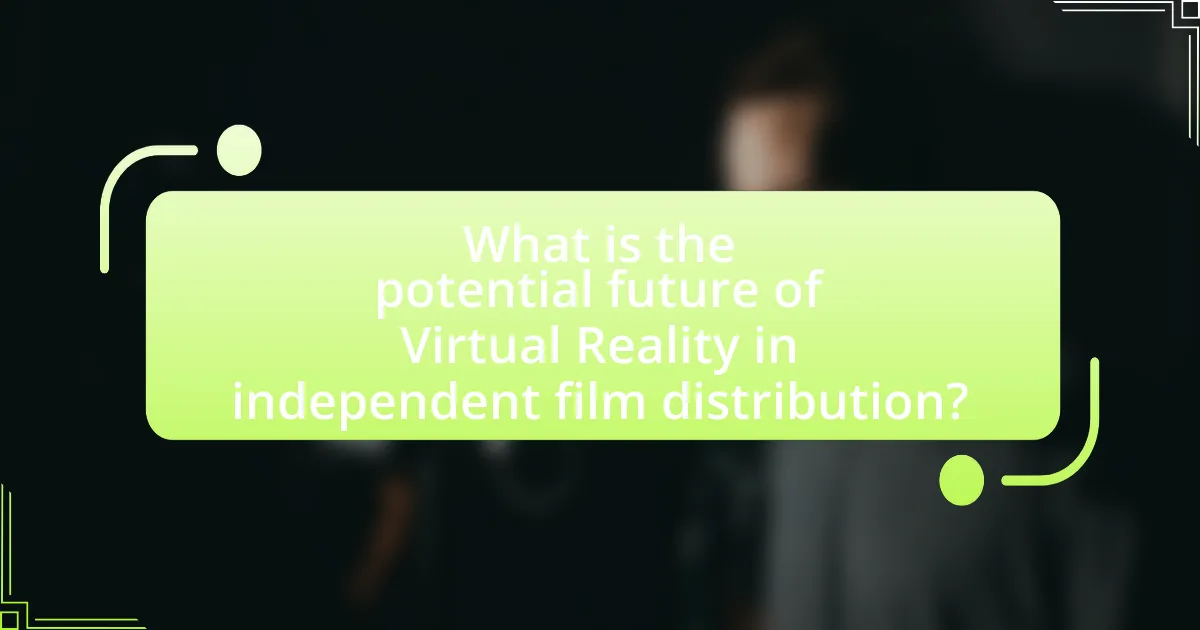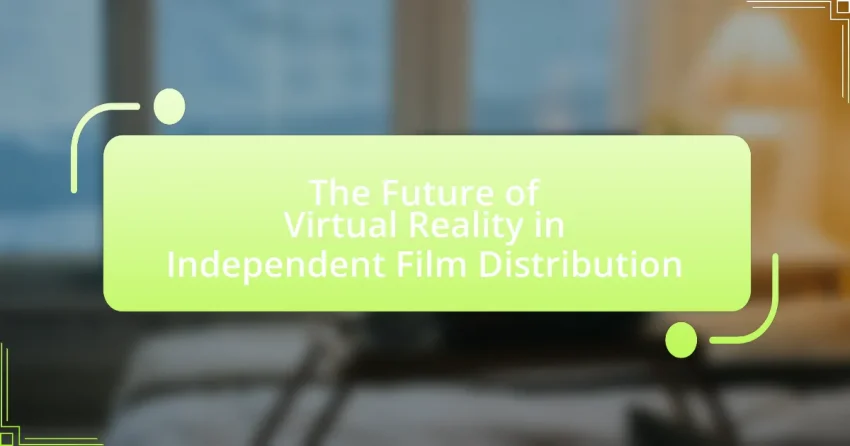The article focuses on the future of Virtual Reality (VR) in independent film distribution, highlighting its potential for growth due to technological advancements and increasing consumer interest. It discusses how VR is transforming the landscape by creating immersive experiences that enhance audience engagement and emotional connection. Key technologies driving this transformation include 360-degree video and VR headsets, while challenges such as high production costs and limited audience accessibility are also addressed. The article further explores how filmmakers are adapting to VR, innovative strategies they are employing, and the role of film festivals in promoting VR content, ultimately suggesting that VR could redefine storytelling in independent films.

What is the Future of Virtual Reality in Independent Film Distribution?
The future of virtual reality (VR) in independent film distribution is poised for significant growth, driven by advancements in technology and increasing consumer interest. As VR technology becomes more accessible and affordable, independent filmmakers can leverage immersive storytelling to engage audiences in unique ways, enhancing viewer experiences beyond traditional formats. According to a report by the International Data Corporation, the global VR market is expected to reach $57.55 billion by 2027, indicating a robust potential for independent films to utilize VR for distribution and audience engagement. This trend is further supported by platforms like Oculus and Viveport, which are actively promoting independent VR content, allowing filmmakers to reach niche audiences directly.
How is Virtual Reality transforming the landscape of independent film distribution?
Virtual Reality (VR) is transforming independent film distribution by creating immersive experiences that engage audiences in novel ways. This technology allows filmmakers to present their narratives in a three-dimensional space, enhancing viewer engagement and emotional connection. For instance, platforms like Oculus and Viveport are enabling independent filmmakers to distribute VR content directly to consumers, bypassing traditional distribution channels. According to a report by the International Documentary Association, VR experiences can increase viewer retention and emotional impact, making them a compelling alternative for independent filmmakers seeking to stand out in a crowded market.
What are the key technologies driving Virtual Reality in film distribution?
Key technologies driving Virtual Reality in film distribution include 360-degree video, VR headsets, and streaming platforms. 360-degree video allows filmmakers to create immersive experiences that engage viewers in a unique way, enhancing storytelling. VR headsets, such as the Oculus Rift and HTC Vive, provide the necessary hardware for users to experience these immersive films, offering high-resolution displays and motion tracking for a realistic experience. Streaming platforms like Oculus TV and YouTube VR facilitate the distribution of VR content, making it accessible to a wider audience. These technologies collectively enhance the viewer’s experience and expand the reach of independent films in the evolving landscape of film distribution.
How does Virtual Reality enhance audience engagement in independent films?
Virtual Reality enhances audience engagement in independent films by creating immersive experiences that allow viewers to interact with the film’s environment and characters. This interactivity fosters a deeper emotional connection, as audiences can explore settings and narratives in a way that traditional films do not permit. For instance, studies have shown that VR experiences can increase empathy and emotional involvement, with a report from the University of Southern California indicating that participants felt more connected to characters in VR scenarios compared to standard viewing methods. This heightened engagement can lead to increased word-of-mouth promotion and a stronger community around independent films, ultimately benefiting their distribution and reach.
What challenges does Virtual Reality face in independent film distribution?
Virtual Reality (VR) faces significant challenges in independent film distribution, primarily due to high production costs and limited audience accessibility. The financial investment required for VR content creation often exceeds the budgets of independent filmmakers, making it difficult for them to produce high-quality experiences. Additionally, the need for specialized hardware, such as VR headsets, restricts audience reach, as not all potential viewers have access to the necessary technology. According to a report by the International Data Corporation, the global VR headset market is projected to grow, but as of 2021, only about 20% of consumers owned a VR headset, highlighting the limited audience base for independent VR films. These factors contribute to the overall challenge of achieving widespread distribution and viewership for independent VR projects.
How do production costs impact the adoption of Virtual Reality in independent films?
Production costs significantly impact the adoption of Virtual Reality (VR) in independent films by limiting the financial resources available for filmmakers to invest in VR technology and content creation. High production costs associated with VR, such as specialized equipment, software, and skilled personnel, can deter independent filmmakers who often operate on tight budgets. For instance, a report from the International Journal of Creative Media Research indicates that the average cost of producing a VR film can exceed $100,000, which is often unfeasible for independent projects that typically range from $10,000 to $50,000. Consequently, the financial barrier created by these production costs restricts the ability of independent filmmakers to explore and innovate within the VR space, ultimately slowing the integration of VR into independent film distribution.
What technical barriers exist for filmmakers using Virtual Reality?
Filmmakers using Virtual Reality face several technical barriers, including high production costs, limited access to advanced technology, and the complexity of VR content creation. High production costs arise from the need for specialized equipment, such as 360-degree cameras and VR editing software, which can be prohibitively expensive for independent filmmakers. Limited access to advanced technology is evident in the disparity between large studios and independent creators, as the former often have better resources and funding to invest in cutting-edge VR tools. Additionally, the complexity of VR content creation requires a steep learning curve, as filmmakers must understand new storytelling techniques and user interactions unique to immersive experiences. These barriers hinder the widespread adoption of VR in independent film distribution.

How are filmmakers adapting to Virtual Reality in distribution?
Filmmakers are adapting to Virtual Reality (VR) in distribution by leveraging immersive experiences to engage audiences more deeply. This adaptation includes creating VR-specific content that enhances storytelling, allowing viewers to experience narratives from a first-person perspective. For instance, platforms like Oculus and Viveport have emerged, enabling filmmakers to distribute VR films directly to consumers, thus bypassing traditional distribution channels. Additionally, filmmakers are utilizing social media and online platforms to promote VR experiences, reaching wider audiences and facilitating community engagement. The rise of VR festivals, such as the Venice Film Festival’s VR section, further validates this shift, showcasing the growing acceptance and demand for VR content in the film industry.
What innovative strategies are independent filmmakers using with Virtual Reality?
Independent filmmakers are utilizing immersive storytelling techniques and interactive experiences as innovative strategies with Virtual Reality (VR). By creating 360-degree narratives, filmmakers engage audiences in a more participatory manner, allowing viewers to explore environments and make choices that influence the story. For instance, projects like “The Invisible Man” VR experience have demonstrated how VR can enhance emotional engagement by placing viewers directly in the protagonist’s perspective. Additionally, independent filmmakers are leveraging crowdfunding platforms to finance VR projects, enabling them to bypass traditional funding routes and connect directly with audiences. This approach not only democratizes the filmmaking process but also fosters community support and investment in unique storytelling.
How are filmmakers leveraging Virtual Reality for marketing and promotion?
Filmmakers are leveraging Virtual Reality (VR) for marketing and promotion by creating immersive experiences that engage audiences more deeply than traditional media. For instance, VR trailers allow potential viewers to experience key scenes in a 360-degree format, enhancing emotional connection and interest in the film. A notable example is the VR experience for the film “The Walking Dead,” which attracted millions of users and generated significant buzz prior to its release. Additionally, filmmakers utilize VR at film festivals to provide interactive experiences, allowing attendees to explore the film’s universe, which can lead to increased word-of-mouth promotion and social media sharing. This innovative approach not only captures audience attention but also differentiates films in a crowded market, ultimately driving ticket sales and viewership.
What role do film festivals play in the acceptance of Virtual Reality films?
Film festivals play a crucial role in the acceptance of Virtual Reality (VR) films by providing a platform for exposure, networking, and validation within the film industry. These festivals often showcase innovative VR projects, allowing creators to present their work to audiences and industry professionals, which can lead to increased visibility and interest in the medium. For instance, events like the Sundance Film Festival and the Venice Film Festival have dedicated sections for VR, highlighting the growing recognition of this format. Additionally, awards and accolades received at these festivals can enhance the credibility of VR films, encouraging further investment and exploration in the genre. The presence of VR at prestigious festivals signals to both creators and audiences that VR is a legitimate and evolving form of storytelling, thus fostering broader acceptance.
How is audience perception of Virtual Reality changing?
Audience perception of Virtual Reality (VR) is shifting towards greater acceptance and enthusiasm as technology advances and applications diversify. Recent studies indicate that 71% of consumers believe VR will significantly impact entertainment and media, reflecting a growing recognition of its potential. Additionally, as VR experiences become more accessible and affordable, audiences are increasingly engaging with VR content, leading to a broader understanding of its capabilities beyond gaming, such as in independent film distribution. This evolving perception is supported by the rise of VR film festivals and platforms that showcase immersive storytelling, further validating its role in the future of cinema.
What factors influence audience acceptance of Virtual Reality films?
Audience acceptance of Virtual Reality (VR) films is influenced by several key factors, including immersion, user experience, narrative quality, and technological accessibility. Immersion is critical, as studies show that a higher level of sensory engagement leads to greater emotional responses and satisfaction among viewers. User experience encompasses the ease of use and comfort of VR equipment; research indicates that discomfort or technical difficulties can deter audience engagement. Narrative quality also plays a significant role; compelling storytelling in VR can enhance emotional connection and retention, as evidenced by audience feedback on successful VR projects. Lastly, technological accessibility, including the availability of affordable VR headsets and platforms, directly impacts the audience’s ability to engage with VR films, as highlighted by market trends showing increased adoption rates with lower-cost devices.
How do demographics affect the reception of Virtual Reality in film distribution?
Demographics significantly influence the reception of Virtual Reality (VR) in film distribution by determining audience engagement levels and technology adoption rates. Younger audiences, particularly those aged 18-34, are more likely to embrace VR experiences due to their familiarity with technology and immersive media, as evidenced by a 2021 report from the International Data Corporation, which found that 70% of VR users fall within this age group. In contrast, older demographics often exhibit skepticism towards VR, primarily due to a lack of exposure and perceived complexity, which can hinder their willingness to engage with VR films. Additionally, socioeconomic factors play a role; individuals with higher income levels are more likely to invest in VR technology, thereby increasing the likelihood of VR film consumption. This demographic divide highlights the necessity for filmmakers and distributors to tailor their marketing strategies to effectively reach and engage diverse audience segments.

What is the potential future of Virtual Reality in independent film distribution?
The potential future of Virtual Reality in independent film distribution is highly promising, as it offers immersive experiences that can enhance storytelling and audience engagement. Independent filmmakers can leverage VR technology to create unique narratives that allow viewers to interact with the film environment, fostering a deeper emotional connection. According to a report by the International Documentary Association, VR experiences can increase viewer retention and emotional impact, making them a valuable tool for independent filmmakers seeking to differentiate their work in a crowded market. As VR technology becomes more accessible and affordable, it is likely that more independent films will utilize this medium, leading to innovative distribution models that prioritize direct-to-consumer experiences and virtual film festivals.
How might advancements in technology shape the future of Virtual Reality in film?
Advancements in technology will significantly enhance the immersive experience of Virtual Reality (VR) in film by improving graphics, interactivity, and accessibility. Enhanced graphics through developments in rendering techniques, such as ray tracing, will create more realistic environments, making viewers feel as though they are part of the film. Increased interactivity, driven by advancements in haptic feedback and motion tracking, will allow audiences to engage with the narrative in a more personal way, influencing story outcomes based on their choices. Furthermore, the proliferation of affordable VR headsets and platforms will democratize access to VR content, enabling independent filmmakers to reach wider audiences. For instance, the global VR market is projected to grow from $15 billion in 2020 to over $57 billion by 2027, indicating a rising interest and investment in VR technologies that can be leveraged by filmmakers.
What emerging trends should filmmakers watch for in Virtual Reality distribution?
Filmmakers should watch for the trend of immersive storytelling in Virtual Reality (VR) distribution, as it enhances audience engagement and emotional connection. This trend is supported by the increasing adoption of VR headsets, with sales projected to reach 43 million units by 2024, according to a report by Statista. Additionally, platforms like Oculus and Viveport are prioritizing content that leverages interactivity and user agency, allowing filmmakers to create experiences that go beyond traditional narratives. This shift towards immersive experiences is reshaping how stories are told and consumed, making it essential for filmmakers to adapt their distribution strategies accordingly.
How could Virtual Reality redefine storytelling in independent films?
Virtual Reality could redefine storytelling in independent films by immersing audiences in interactive narratives that allow for personal engagement with the story. This technology enables filmmakers to create environments where viewers can explore settings and interact with characters, enhancing emotional connections and investment in the narrative. For instance, projects like “The Invisible Man” in VR have demonstrated how spatial storytelling can create a more profound experience, allowing viewers to feel as if they are part of the story rather than passive observers. This shift not only transforms the viewer’s role but also opens new avenues for creative expression, enabling independent filmmakers to experiment with non-linear storytelling and unique perspectives that traditional film cannot offer.
What best practices should independent filmmakers follow when using Virtual Reality?
Independent filmmakers should prioritize immersive storytelling when using Virtual Reality (VR). This involves creating narratives that fully engage the audience’s senses and emotions, allowing them to experience the story from multiple perspectives. Filmmakers should also consider the unique spatial dynamics of VR, utilizing 360-degree environments to enhance the viewer’s sense of presence.
Additionally, independent filmmakers should focus on user interaction, designing experiences that encourage audience participation and exploration. This can lead to a more personalized and impactful viewing experience. Furthermore, optimizing content for various VR platforms is crucial, as different devices may have varying capabilities and user interfaces.
Finally, filmmakers should conduct thorough testing with target audiences to gather feedback and refine their VR projects, ensuring that the final product resonates well with viewers. These practices are supported by industry trends indicating that immersive and interactive content significantly enhances viewer engagement and satisfaction in VR environments.
How can filmmakers effectively budget for Virtual Reality projects?
Filmmakers can effectively budget for Virtual Reality projects by conducting thorough pre-production planning that includes detailed cost estimates for technology, talent, and post-production. This involves identifying specific VR hardware and software requirements, which can range from high-end headsets to specialized cameras, and estimating their costs, which can exceed $10,000 for professional-grade equipment. Additionally, filmmakers should allocate funds for skilled personnel, such as VR developers and 3D artists, whose rates can vary significantly, often starting at $50 per hour.
Moreover, filmmakers must consider the unique aspects of VR production, such as the need for extensive testing and user experience design, which can add 20-30% to the overall budget. According to a report by the International Journal of Creative Media Research, projects that incorporate these elements tend to stay within budget and achieve higher audience engagement. By integrating these budgeting strategies, filmmakers can ensure that their VR projects are financially viable and creatively successful.
What resources are available for filmmakers to learn about Virtual Reality distribution?
Filmmakers can access various resources to learn about Virtual Reality (VR) distribution, including online courses, industry reports, and dedicated platforms. Online platforms like Coursera and Udemy offer courses specifically focused on VR content creation and distribution strategies. Industry reports from organizations such as the International Documentary Association provide insights into current trends and best practices in VR distribution. Additionally, platforms like Oculus and Steam offer developer resources and guidelines for distributing VR content effectively. These resources collectively equip filmmakers with the knowledge and tools necessary to navigate the evolving landscape of VR distribution.
